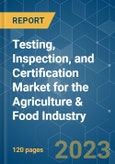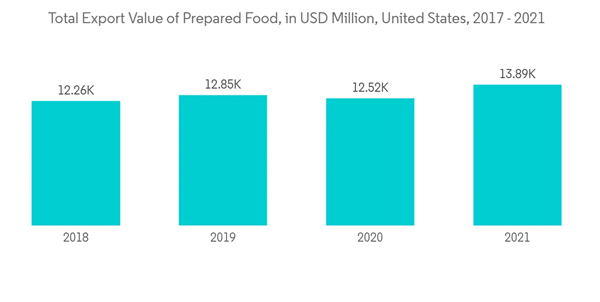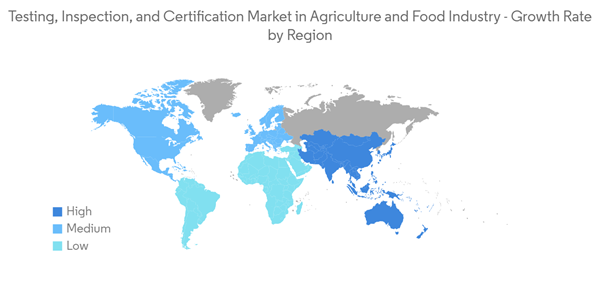The Testing, Inspection, and Certification Market for the Agriculture & Food Industry is expected to grow by registering a CAGR of about 7.6% during the forecast period. The rising consumer awareness about food safety and the increasing focus of governments across various countries on food quality to ensure food safety are among the primary factors driving the demand for testing, inspection, and certification (TIC) services across the agriculture & food industry.
This product will be delivered within 2 business days.
Key Highlights
- Agricultural products often have a complex path, from the fields or farms to the end consumers. As these products directly impact the health of the consumers, it becomes increasingly important to have testing/inspection measures in place. Additionally, food/agriculture certification helps companies in these domains to trade internationally without barriers. Various testing, inspection, and certification programs across the agriculture & food industry include FSSC 22000 - Food Safety System Certification, BRCGS, ISO 22000 - Food Safety Management System, PBS, GMP+/FSA en GMP+/FRA certification, and ROC - Regenerative Organic Certified, among others.
- To cater to various requirements of the agriculture & food industry, a wide range of TIC services have been designed, which include nutrition and ingredients testing, testing and analysis of chemical compounds, biodegradation test, an inspection of food safety and hygiene, inspection of quantity and quality, inspection in the process of production, certification of standardized products, verification of supply units, among others.
- With the expansion of global trade, it has become essential to take reasonable measures to eliminate risk for agricultural products throughout the supply chain, maintain integrity, and provide much-needed transparency. For instance, according to the European Commission, in April 2022, the value of EU agri-food trade reached a total of EUR 31.4 billion (~USD 33.15 billion), an increase of 14% compared to the same period of the previous year. As European countries have some of the most stringent regulations for agricultural and food products, the growing trade of these products is expected to drive the demand for TIC services.
- Additionally, more government activities to ensure food safety across various countries and more rigorous certification and standard requirements for food are becoming mandatory to ensure these products are safe and healthy to consume. The continuous improvement in sanitation drive and growing environmental monitoring initiatives undertaken by government and non-government organizations are also expected to have a notable impact on the the market studied.
- However, the lack of a common global standard, relaxation provided by governments across various countries, and low awareness about food quality and testing, inspection, and certification services, especially across developing countries, are among the major factors challenging the growth of the market studied.
- COVID-19 had a notable impact on the growth of the market studied. Although most countries deemed the food & beverage industry essential, ensuring minimal impact on the demand side, several companies operating in the agriculture & food industry faced difficulties procuring raw materials due to supply chain disruptions. Furthermore, governments across various countries also relaxed the quality norms to ensure sufficient availability of food products, negatively impacting the demand for TIC services.
Agriculture & Food Industry Testing, Inspection, & Certification Market Trends
Increasing Consumption of Packaged Food to Drive the Demand for TIC Services
- The last few decades have witnessed a gradual increase in the demand for packaged food. Modern lifestyles and changes in consumer behavior have led to a rapid rise in the demand for packaged/frozen products and ready meals. Processed foods, such as Pizza, Pasta, and frozen products, such as meat and fish, are becoming increasingly popular among consumers. Furthermore, with economic development and adequate food supplies, food quality and safety are also gaining attention among consumers, driving the demand for TIC services.
- According to the World Bank, about 57% of the global population lives in urban areas. Rapid urbanization, especially in developing economies, is driving the demand for agricultural products, which in turn is encouraging vendors to launch more packaged food products as they help in extending the shelf-life of edible products.
- Globalization of the agriculture & food industry is also among the key factor driving the growth of the packaged food industry, as leading food-producing countries are targeting the food-scarce markets to export their products. For instance, according to the US Census Bureau and USDA, the total export value of the United States prepared food reached USD 13,888 million in 2021.
- Several global manufacturers of food products are adopting outsourcing service models to cater to the growing demand. Although it has been beneficial in many aspects, a surge in illicit trading and adulteration cases has enhanced the need for testing, inspection, and certifications in the food industry and the growth of the same.
- According to the World Bank estimates, about 600 million, or almost 1 in 10 people, fall sick after eating contaminated food, and about 420 000 die yearly. With the increasing cases of adulteration of unwanted substances in many food products, such as oil, milk, and others, the need for a robust TIC system is also expected to grow.
Asia Pacific to Become the Major Demand Driver
- Agriculture is among the major economic sectors of various countries in the Asia-Pacific region, such as India, China, Malaysia, and so on. Although the sector has primarily been unorganized, in recent years, a shift in the industry's landscape has been observed mainly due to the commoditization of agricultural products and the entry of global food & beverage companies. Furthermore, exposure to developed countries has further enhanced the general awareness among consumers about food safety, creating a favorable market scenario for the growth of TIC services.
- The growing government-enforced certification requirements and industry regulations are also projected to drive the demand for TIC in the food & beverage industry. For instance, in August 2022, the China National Health Commission (NHC), together with the State Administration for Market Regulation (SAMR), unveiled 36 new national food safety standards and three amendments. Moreover, with the rising growth in the TIC market now, the intervention of emerging digital technologies and increasing demand for interoperability testing are also expected to boost the development of the Testing, Inspection, and Certification (TIC) market in the food & beverage industry.
- Apart from having a large consumer base, several countries of the Asia-Pacific region are among the leading exporters of agricultural and food products. As the exported products need to fulfill international regulatory guidelines and industry standards, the expanding export market is expected to impact the demand for TIC services positively.
- For instance, according to China Customs, the export value of agricultural products from China increased from USD 76.03 billion in 2020 to USD 84.35 billion in 2021. The country also imports a significant amount of agricultural products, with the United States being among the major exporters. According to USDA, in 2021, the United States' agricultural export to China increased to USD 32,977 million from USD 26,399 million in 2020.
- Considering the growing demand, several new players are entering the Asia-Pacific TIC market, while the existing players are focusing on offering farm-to-fork conformity assessment services that seek to use innovative techniques, such as live data feeds on crops to more traditional inspections of ship containers and trucks, to ensure that food safety requirements and standards are met at each level of the supply chain.
Agriculture & Food Industry Testing, Inspection, & Certification Market Competitor Analysis
The Testing, Inspection, and Certification Market for the Agriculture & Food Industry has a mixed presence of new and established players, which is increasing the competitiveness among the players. The vendors operating in the market focus on becoming a one-stop solution provider by integrating new solutions and certifications into their portfolios. Furthermore, partnerships, mergers, and acquisitions are among these players' other major strategic priorities. Some major vendors operating in the market include Bureau Veritas SA, Cotecna Inspection SA, SGS SA, and Intertek Group Plc, among others.- August 2022 - The Protection of Plant Varieties and Farmers' Right Authority (PPVFRA) under the agriculture ministry announced that it is conducting field testing and assessments of more than 11,000 new seed varieties of cotton, cereals, vegetables, oilseeds, spices, flowers, and legume crops to boost research & development of new seed varieties, and to protect rights of plant breeders through the grant of Intellectual Property Rights (IPR) certification.
- May 2022 - Bureau Veritas, opened its third US microbiology laboratory located in Reno, Nevada. The new laboratory offers microbiology indicator analyses as well as rapid pathogen testing to ensure the safety of food and agriculture commodities.
Additional benefits of purchasing the report:
- The market estimate (ME) sheet in Excel format
- 3 months of analyst support
This product will be delivered within 2 business days.
Table of Contents
1 INTRODUCTION
4 MARKET INSIGHTS
5 MARKET DYNAMICS
6 MARKET SEGMENTATION
7 COMPETITIVE LANDSCAPE
Companies Mentioned (Partial List)
A selection of companies mentioned in this report includes, but is not limited to:
- Bureau Veritas
- SGS SA
- Cotecna Inspection SA
- Intertek Group Plc
- AMARC Public Co. Ltd
- TUV SUD
- AIM Control Inspection Group
- FARE Labs Pvt. Ltd
- Applus+ Group
- AsureQuality Limited
- Kiwa Ltd
- MISTRAS Group Inc.
Methodology

LOADING...









![Food Safety Testing Market: Trends, Forecast and Competitive Analysis [2024-2030] - Product Image](http://www.researchandmarkets.com/product_images/12625/12625153_60px_jpg/food_safety_testing_market_[20242030].jpg)
